Many of you who travel to Sapa either independently or on a packaged tour to Sapa set the goal of conquering Fansipan peak – the roof of Indochina – in your itinerary. Why? For the thrill of adventure, conquering the forest trails, climbing stairs to the point of exhaustion, and then suddenly bursting with emotion when reaching the stainless steel peak marking the roof of Indochina. It’s also an amazing feeling to stand on the high mountain peak, gaze down at the panoramic view of the Sapa valley below, a feeling that is very different from just wandering around and sightseeing in the town. Additionally, for those who enjoy spiritual travel, you cannot miss the Buddha statues, pagodas… in the Fansipan Legend complex, including the highest bronze statue of Amitabha Buddha in Vietnam. Are you intrigued yet? Let’s explore the journey of conquering Fansipan Sapa with Cuong!
1. Where is Fansipan peak located?
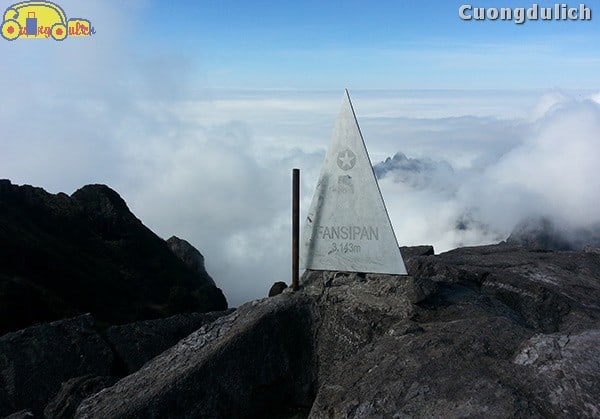
Fansipan is the highest mountain in Vietnam and also the highest in Indochina, hence it is known as the “Roof of Indochina”. Fansipan mountain is 3,143 meters above sea level, located in the center of the Hoang Lien Son range, on the border between Lai Chau and Lao Cai provinces. Many travelers who go to Sapa often stay in hotels in the town center, so Cuong has researched the distance to help you: Fansipan mountain is 9 km southwest of Sapa town.
Stretching 280 km from Phong Tho to Hoa Binh, the widest part of the Hoang Lien Son mountain range is about 75 km, and the narrowest is 45 km, consisting of three blocks, the Bach Moc Luong Tu block, the Fansipan block, and the Pu Luong block. This massive roof hides many wonders, but the most mysterious and alluring, attracting the desire to conquer of many mountaineers, is Fansipan peak.
At the foot of the mountain are rice fields, jackfruit trees, and bamboo with a dense density creating landmarks like Coc Leu (Rice Field), Coc San (Jackfruit Field)… Due to Fansipan’s height of over 3,000 meters, when climbing the mountain, you will experience various weather zones.
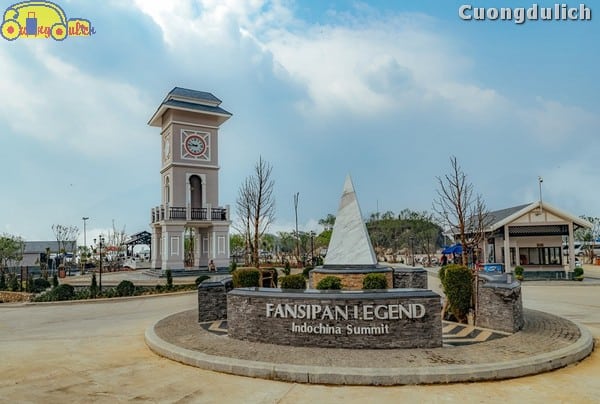
From the foot of the mountain to an altitude of 700 meters is a tropical belt with dense primeval forests, tangled with climbing vines. From 700 meters upwards is the canopy layer with trees like pơmu trees, some with a circumference so large that four people holding hands can’t reach around, reaching heights of about 50-60 meters, and ages up to several hundred years. Pơmu (ngọc am) is known as the “gold mine” of Lào Cai. Alongside pơmu, there are many other rare and precious types of wood such as: lãnh sam, thiết sam, liễu sam, kim sam, thông đỏ, hoàng đàn… The forest is filled with conifers intertwined with small deciduous trees, their trunks always swollen with water because the higher they grow, the more rain they receive, with some years seeing continuous rain on Fansipan for a whole month.
Mixed in with the coniferous forest are various types of rhododendrons, orchids, and bright azaleas. Almost every season, SaPa is filled with a myriad of colorful flowers: orchids, daisies, estcola… which are rare in the lowlands. Rhododendrons alone have four genera with dozens of different species. Some places are covered with vibrant rhododendrons throughout the mountainous forests. It’s no wonder that near the peak of Fansipan, there is a path called the Rhododendron Flower Road. Here, if you take the train from the station to the Fansipan cable car station to reach the summit, you will be able to admire the entire rhododendron forest. Later, when discussing the different ways to reach the summit of Fansipan, Cuồng will provide more detailed information! In our country, there are 111 genera of orchids and 643 species, while Fansipan alone has up to 330 species.
2. Should you conquer the summit of Fansipan during the stormy season?
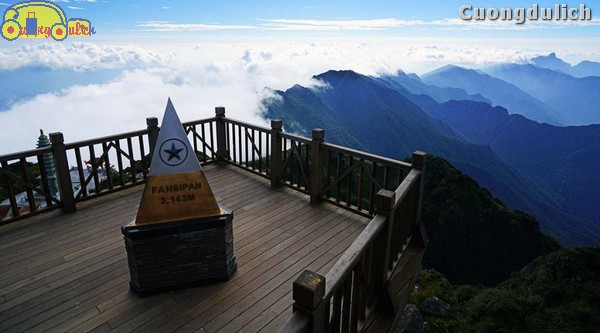
If you plan to conquer the peak of Fansipan by trekking through the icy mountains and forests, according to Cuong, you need to carefully choose the timing and pay attention to the weather. Climbing a mountain in rainy weather can make the journey extremely difficult. The mountain paths become slippery and cold, the foggy misty weather makes it hard to observe the beautiful scenery, and most importantly, it increases the risk of danger and slipping due to poor visibility of the trail.
Therefore, Cuong suggests that if you intend to climb the mountain to conquer Fansipan, you should avoid going during the rainy season. The best time to climb Fansipan is in October and November, when the rain has stopped but winter has not fully arrived, or in February and March, when the weather transitions to spring and the rainy season has not yet begun. Climbing the mountain at the end of March, if lucky, you may encounter blooming azalea forests, as beautiful as a painting. Once, Cuong climbed Fansipan in February during Tet (Lunar New Year) and was fortunate to see some early blooming azaleas. It’s best to check the weather in Sapa a day or two before climbing, to avoid any impact on the trekking process.
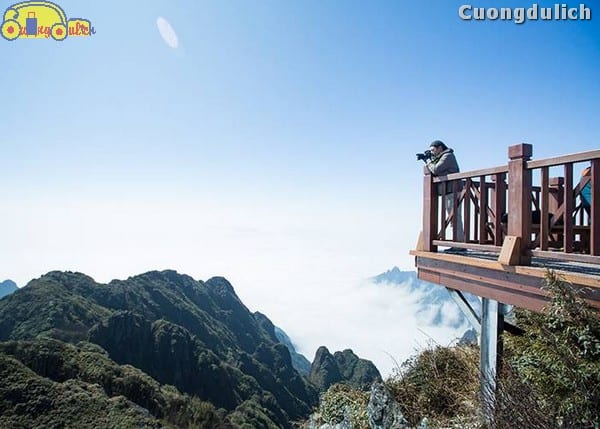
For those of you conquering the summit of Fansipan by cable car, the weather, whether rainy or not, doesn’t matter much, as the cable car will take you to the top of Fansipan in just 15 minutes. But if you go during the rainy season, Cuong guarantees that even when you reach the top of Fansipan, you won’t be able to enjoy the view because it will be covered in fog. Cuong went to Sapa once in September, and even then, when climbing Fansipan, it was still enveloped in clouds, making it impossible to see anything in the Muong Hoa valley below. Also, if you want to take the cable car to the top of Fansipan on rainy days, if there is too much rain and fog at the top, the cable car won’t operate for safety reasons, so you’ll have to wait until the weather clears up before the cable car can run. Therefore, to be cautious and avoid any mishaps, make sure to carefully choose the timing before conquering the summit of Fansipan!
3. How to conquer the summit of Fansipan?
This question is too easy, Cuong will answer right away. You have 2 ways to reach the roof of Indochina. The traditional way, of course, is to climb the mountain. The second way, more modern and luxurious, suitable for those who are not into hiking, is to take the cable car.
3.1 First, Cuong will review in detail about climbing Fansipan mountain!
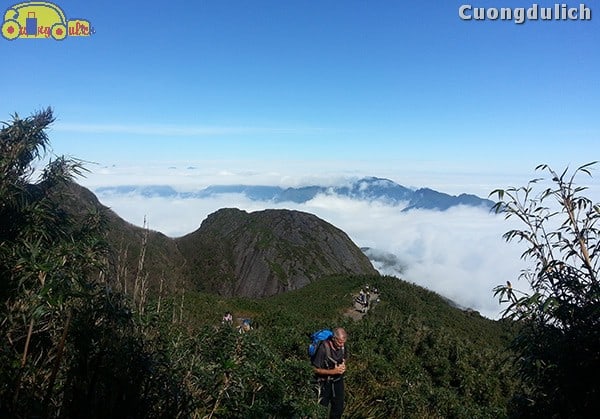
As an adventure enthusiast, Cuong is proud to have conquered the summit of Fansipan mountain several times with just his own feet, so he has a lot of experiences to share with you. Previously, it used to take 5 to 6 days to reach the top of Fansipan, but now that time has been shortened to only about 2 to 3 days. Cuong thinks that is much more reasonable, for example, if you have a few days for a Sapa tour, you can spend 2-3 days climbing Fansipan, which won’t take up too much time, leaving you with time to visit tourist spots in the town like Sapa market, stone church, or Ham Rong mountain. Cuong knows that there are now many 3-day 2-night or 2-day 1-night Fansipan climbing tours available, so you can check them out!
In order to participate in the mountain climbing journey, you need to have good health, prepare essential equipment, and one crucial factor is having a guide.
On the way to conquer the summit of Fansipan, sometimes you should stop to admire the fascinating natural scenery of the Hoang Lien Son mountain range. At an altitude of 2,400 meters, reaching this point is quite high and you can touch the clouds. You will feel like the wind and clouds blend with the forest, extending your hand as if you can grasp the clouds.
Going higher, at an altitude of 2,800 meters, the fog suddenly disappears, the sky becomes clear, blue, with only the wind blowing, making the vegetation cling to the rocks. You will feel like passing through a cloud field and reaching the sky.
a. Itinerary for climbing to the summit of Fansipan
To provide a detailed review of the route, Cuong would like to share that he and his friends drive up to Tram Ton station at an altitude of 1,900 meters. Although Fansipan mountain is 3,143 meters high, in reality, you only climb… not even half, so don’t be scared by the mountain being over 3,000 meters high!
In fact, to climb Fansipan mountain, you can choose from 3-4 different routes. Just ask the local guides, they will show you various paths from easy to extremely difficult, only suitable for mountain climbing experts. But for Cuong, considering his average mountain climbing skills and saving energy for sightseeing after reaching the summit of Fansipan, he chooses to climb via the Tram Ton route.
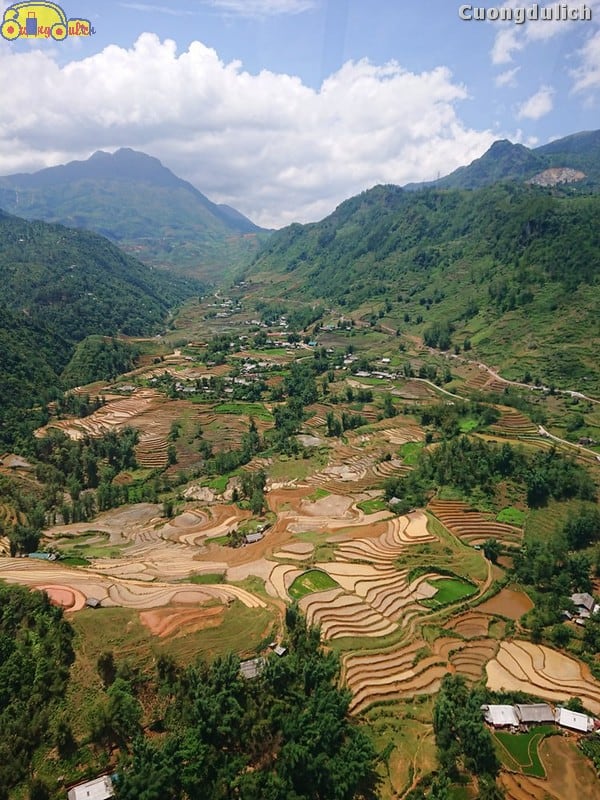
From Tôn station to deep into the forest at an altitude of 2,000 m, the road is not too difficult to walk, you just need to pay attention to a few slippery high slopes. When reaching an altitude of 2,800 m, it becomes even more challenging, with steep and treacherous slopes, but the breathtaking scenery of the majestic mountains standing tall, solemn in the wind makes up for it.
When you are about 300 m away from the summit, you can see the stainless steel peaks marking the top of Fansipan with the Vietnamese flag flying in the wind. Now sitting here typing, Cuồng feels like reliving the mountain climbing journey of that day. When getting closer to the summit and seeing the national flag, Cuồng feels no fatigue at all, as if running up to the top to reach a high peak, encompassing the vast space below in sight. A very proud feeling, as if saying I’m the king of the world after conquering a great challenge.
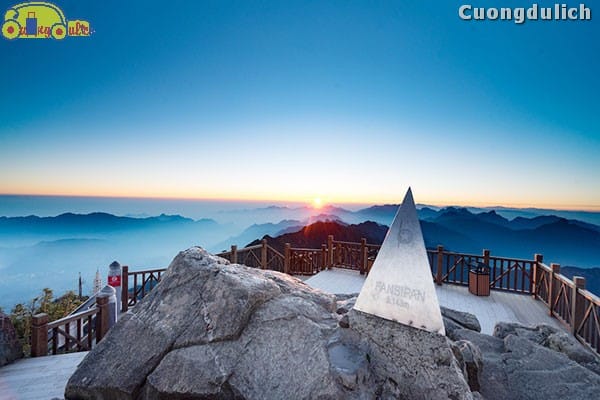
According to the ethnic language, the peak of Fansipan is called “Hua Si pan”, meaning a large rock. Because on the top is a giant rock, surrounded by smaller rocks. Currently, the old 3,143m high stainless steel peak marking the top of Fansipan has been fenced off by the tourist area. You will not be able to take pictures next to this old peak. However, the tourist area has built 3 new, more beautiful, larger, and more luxurious stainless steel peaks to help you easily take check-in photos.
After talking about climbing up to the top of Fansipan, Cuong talks about climbing down the mountain. Climbing down the mountain is more difficult than climbing up, because you are descending from a high mountain, so the path feels very steep, sometimes you feel like you are sliding due to inertia, not being careful or bumping into others can easily lead to falling. You should start early to descend the mountain safely, not wandering in the mountain forest at night.
b. What do you need to prepare before climbing Fansipan?
1. There are two most important items that need to be carefully selected, one is a set of comfortable, stretchy, moisture-wicking, warm clothes, and the other is a pair of very good shoes. Clothing can be khaki pants, long-sleeved turtleneck sweaters, outer sporty jackets for easy movement. Cuong knows that the market now sells many lightweight windproof clothing sets that are not waterproof, very suitable for mountain climbing and the humid, foggy weather in Sapa. Also, when climbing to high mountains, the temperature drops very low and there is strong wind, so remember to prepare extra towels, and a headscarf.
2. Shoes must be good quality hiking shoes, it is better to buy waterproof shoes to be able to cross shallow water areas, accompanied by thick sports socks. Remember that if the shoes are not suitable and cause foot pain while climbing, you will have a hard time reaching the top of Fansipan. Cuong also warns that climbing Fansipan is extremely tough on shoes, so if you have cute or expensive designer shoes, keep them aside for another occasion, don’t wear them to climb Fansipan. Otherwise, after the climbing trip, your designer shoes will be ruined. A local guide told Cuong that he gets new shoes every 2-3 months because shoes wear out quickly, even good shoes only last a little longer! In general, remember to prepare good shoes, or else you might have to change “horses” in the middle of the road without having any horses to change to!
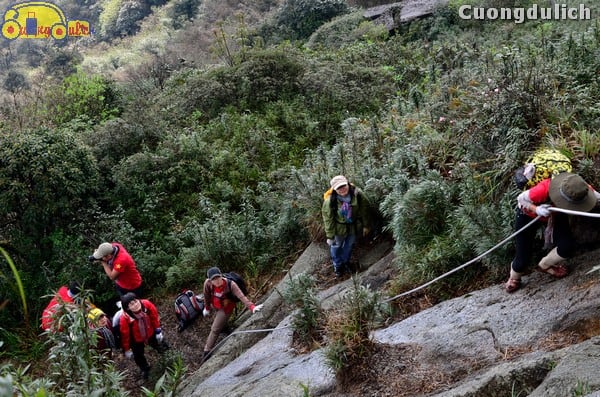
3. After choosing the items you like, to make sure, you must try on the clothes and shoes you plan to use for the mountain climbing trip. You can walk or run every morning in this outfit, or walk up and down the stairs several times with a backpack on your shoulder carrying some necessary items to check if the clothes and shoes are completely comfortable.
4. You must eat nutritious food and get enough sleep. Being exhausted, tired, or overly stressed at work will greatly affect your mountain climbing journey. If you are worn out from meeting deadlines and decide to relax in Sapa, Cuong always advises taking the cable car for a break, as if you are already tired, how can you have the energy to climb mountains.
5. You should contact a knowledgeable, enthusiastic guide who is familiar with the terrain. If they are Hmong guides or local guides in Sapa, even better, the cost for a guide carrying equipment ranges from 300,000 VND to 500,000 VND per day.
6. Prepare a tent and sleeping bag: There are 2 overnight stops on the way, one at an altitude of 2,200 meters. The temperature at this point in winter is around 8-10 degrees Celsius, and in summer around 12-15 degrees Celsius. The other stop is at an altitude of 2,800 meters, with temperatures in winter around 1-5 degrees Celsius, and in summer around 10-15 degrees Celsius. So if you don’t want to shiver in the cold or get bitten by mosquitoes in the forest, remember to bring a sleeping bag to crawl into at night.
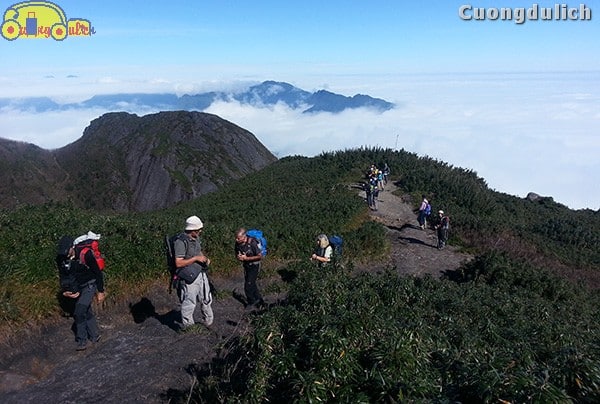
7. Before climbing the mountain for about 3-5 days, Cuong prepares for this journey by regularly exercising, such as walking, practicing yoga, running, limiting smoking… For those who are too lazy, when you arrive at the company, practice by taking the stairs instead of the elevator. Always keep yourself in a good spirit, relaxed, and cheerful.
8. Some types of medicine to prepare: anti-diarrhea medicine, cold medicine, fever medicine, aromatic balm, medical alcohol, cotton, bandages in case of scratches while climbing, Salonpas patches for sore muscles after a long day of climbing. Make sure to prepare first aid supplies thoroughly, in case of accidents on the mountain, you have them ready to use, because these items are not easy to find on the mountain.
9. For those who are not physically fit, Cuong advises you to take care of yourself, encourage yourself not to lose heart and rely on others, affecting the group. If you really can’t continue, you have to go back to the waiting place for the group to return. People with heart disease, high blood pressure, respiratory failure, and pregnant women should not climb mountains.
10. In the days before climbing, you should eat nutritious food, provide vitamin C, drink enough water, limit alcohol, and most importantly, get at least 7 hours of sleep per day. For those who are on long-term medication, remember to bring your medication on the trip.
11. Regarding food and drinks: Bring simple, light food to pack neatly in your backpack, rich in nutrients such as bread, pastries. Each person should prepare about 3-4 small bottles of water. Drink water in small sips multiple times, do not drink too much at once as it will make it difficult to walk, moreover, avoid drinking too much water at the beginning, as you may run out of water when reaching the mountain top and feel thirsty.
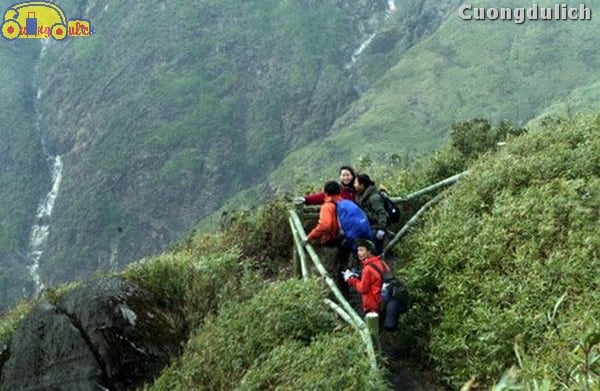
12. In addition, there are many other essential items that you need to prepare for your trek up Fansipan mountain, such as hand sanitizer because the mountain trails are dirty and there are not many places to wash your hands, bring drinking water to wash your hands to avoid discomfort, a flashlight, tissues, a personal raincoat for sudden rain or thick fog that can be very wet, insect repellent, prepare extra socks in case your socks get wet while crossing streams, gloves because there are places on the mountain where you need to hold onto rocks, tree roots… with gloves you don’t have to worry about dirty hands or scratches, for those who are afraid of scratches, you can also prepare ankle, wrist, and knee guards,
13. All the luggage mentioned above, you should divide into two different backpacks, one large backpack to be carried by the luggage carrier, and a small compact backpack, not exceeding 2kg, for you to carry with you. For the backpack you carry with you, you should choose one with a fixed strap across the chest to increase protection. You should choose a large backpack with multiple compartments to store many items and easily categorize them.
14. In the large backpack, you should pack warm clothes, personal blanket, sleeping bag, clothes, all non-urgent items for the journey. The small backpack should contain food, water, flashlight, raincoat, and some medical supplies.
15. You should prepare a trekking pole for the journey. There are usually many poles left at the foot of the mountain by previous hikers. This item is essential for your journey.
c. Things to keep in mind during the Fansipan mountain trek

1. On the way, difficult sections require calmness and caution. Do not step forward until you feel truly stable and confident. Be extremely cautious. Take deep breaths throughout the journey to conserve energy. When tired, breathe in through the nose and out through the mouth to maintain better endurance.
2. You can use your mobile phone at many points along the mountain climbing journey. However, there are places without signal, so don’t forget the following solutions: Establish communication signals in advance, Determine stopping points to wait for each other, if there is a route map, Divide into groups if in a large group, Support tools: whistle, walkie-talkie, flashlight, fireworks, marking flags, Pre-determined emergency signals, Follow the guide’s instructions, travel in groups, do not separate from the group.
3. During the journey, pay attention to: Protecting the forest, maintaining environmental hygiene, don’t think that mountain trails don’t need environmental cleanliness, if you hike and keep seeing piles of trash left by previous groups, it will be very unpleasant, right? Do not litter along the way, when there is trash, put it in a bag or backpack and dispose of it at each stopping point. Do not carve on rocks, carve on trees along the way, Do not cut trees, light fires in the forest especially during dry season.
See more:
Extremely Detailed Review of 20 Sapa Travel Destinations for First-Time Sapa Visitors
Top Most Prominent Tourist Attractions in Sapa
3.2 Conquering Fansipan Peak by Cable Car
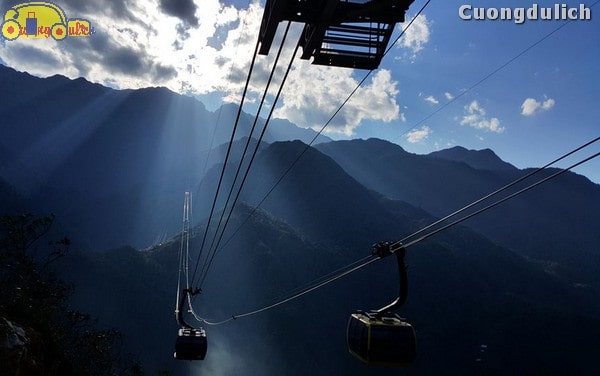
Since the cable car system Fansipan – Sun World Fansipan Legend was opened and inaugurated in February 2016, the dream of conquering the roof of Indochina of many people has become a reality, conquering the peak of Fansipan at 3,143 meters has never been easier. This type of activity is suitable for all ages from the elderly to children, in less than an hour, tourists can conquer the peak of Fansipan thanks to the cable car system certified to win 2 Guinness records. For those with weak health or those who prefer not to climb mountains but just want to reach the top of Fansipan for a check-in photo, Cuong recommends taking this cable car route.
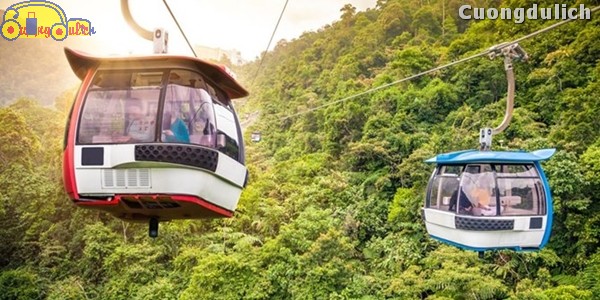
The Fansipan cable car system holds two Guinness World Records: the longest three-rope cable car system in the world with a total length of 6292.5 meters, and the three-rope cable car system with the largest height difference between the departure and arrival stations in the world, with a height difference of 1410 meters. Hearing about these Guinness World Records, you must feel proud. The cable car system started operating in 2016 and is regularly maintained, so you can completely trust its safety. The construction took 2 years under challenging terrain and harsh weather conditions. All materials had to be manually transported from the bottom to the top of the mountain. This shows the immense effort and hard work put into building this modern cable car system for us to visit the summit of Fansipan.
a. How to buy tickets for the Fansipan cable car?
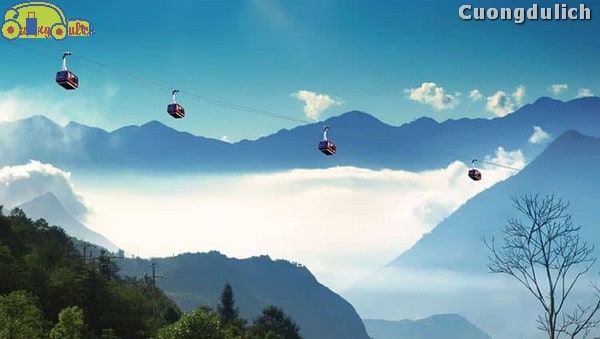
If you are traveling to Sapa in a large group or during peak times, and want to buy a cable car ticket to Fansipan, you should book in advance with the hotel where you are staying in Sapa. Cuong knows that many hotels in Sapa now offer services to book tickets to visit tourist attractions in Sapa, such as booking tickets for the Fansipan cable car, tickets to visit Ham Rong Mountain… which is very convenient for tourists. In addition, the hotels also provide services to rent a car to take you to the tourist attractions, so you don’t have to worry about getting lost in an unfamiliar place.
However, if you are traveling in a small group of about 4-5 people or during off-peak times, you can buy tickets directly at Sun Plaza right in the center of Sapa town or at Sapa station. The advantage of buying tickets directly is that you will receive additional vouchers for discounts on dining services at restaurants within the Fansipan Legend complex. Additionally, you will receive more specific advice and guidance on how to purchase the mountain railway tickets in the most economical and suitable way.
b. How to get to the Fansipan cable car station?
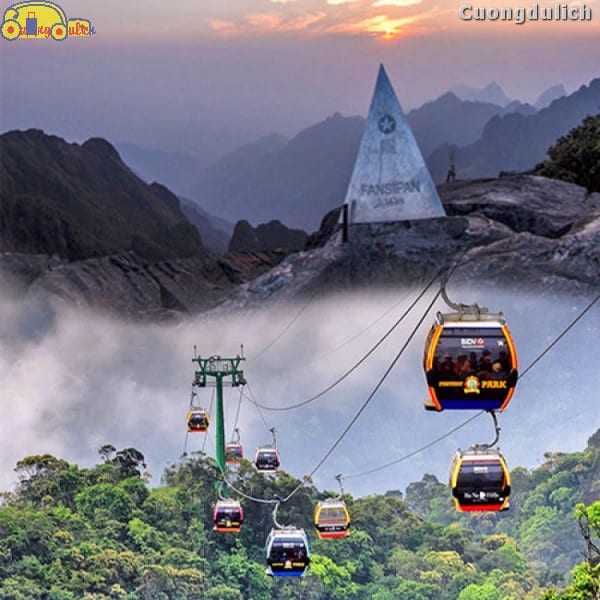
The Fansipan cable car station is about 3km to the northwest of the center of Sapa town. To get from the center of Sapa town to the Fansipan cable car station, you can choose one of the following ways:
1. Walk along Thac Bac street for 1km, then turn left onto Nguyen Chi Thanh street for another 2km until you reach the cable car station. Along the way, there are signs directing you, making it easy to find the way to the station without needing to ask for directions. The walk takes about 30 minutes, and if you want to energize yourself before exploring the summit of Fansipan and other fun attractions, you can consider the following options.
2. Take bus route number 05 from Sapa Stone Church to the cable car station, ticket price is 10,000 VND/one way/passenger.
3. Take a taxi from Sapa Stone Church to the cable car station, about 3km, price ranges from 50,000-100,000 VND.
4. In addition, another popular option that many tourists choose when traveling from Sapa town to the Fansipan cable car station is by train. Starting from March 31, 2018, Sun World Fansipan Legend introduced the Mường Hoa mountain railway line, connecting from the MGallery hotel in Sapa town to the Fansipan cable car station.
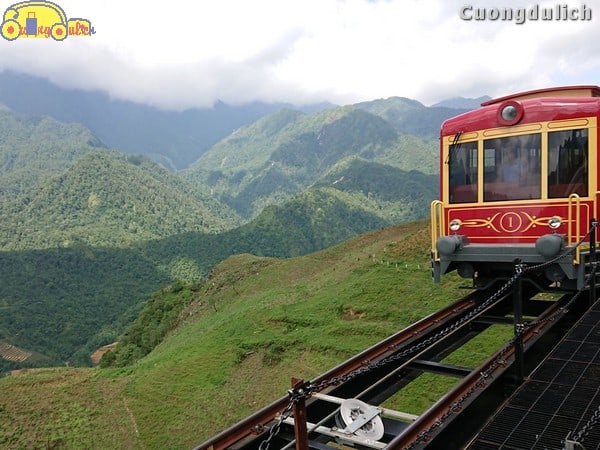
This is the longest and most modern mountain railway line in Vietnam, designed in a classic European style, passing through 2 tunnels and 4 bridges to reach the Fansipan cable car station. The highlight of this mountain railway line to the Fansipan cable car station is that the entire train is painted in bright red, resembling the high-speed train carrying students to Hogwarts in the Harry Potter story. With a maximum speed of 10 m/s and a capacity of 2,000 passengers per hour, the railway line shortens the travel time from Sapa town to the Fansipan cable car station to just 4 minutes instead of the 15-20 minutes by taxi.
The round-trip ticket for the mountain railway is 200,000 VND for adults and 150,000 VND for children from 1m to 1.3m. Buying a combo ticket for the railway + Fansipan cable car will get you a 50,000 VND discount per ticket, and an additional food and drink voucher at the Vân Sam restaurant located at the Fansipan cable car station. You can purchase tickets and board the train at the MGallery hotel.
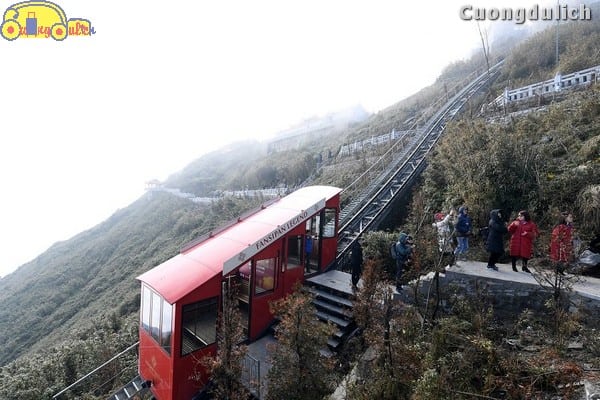
From high up in the middle of the mountain range, through the glass windows of the Mường Hoa mountain train, you will be captivated by the majestic scenery of the Northwest mountains with green and yellow rice fields, combined with the evening smoke on the roofs of the village houses. All of this contributes to creating the most complete experience for you when visiting this land.
c. Operating hours, ticket prices for the Fansipan cable car

The operating hours of the Fansipan cable car are from 7:30 to 17:30 daily at Hoang Lien Station – Fansipan Station. This means you can take the cable car to the top of Fansipan at any time during the day. However, Cuong recommends taking the cable car in the afternoon when there is less fog, bright sunlight, to fully enjoy the beautiful scenery of the Muong Hoa Valley from above and take some stunning photos.
The ticket price for the Fansipan SaPa cable car for visitors is 700,000 VND for adults, 500,000 VND for children (children from 1m – 1m3), and free for children under 1m tall accompanied by an adult. The cable car ticket is a round-trip ticket for both ways, and it is a card, so after you purchase and use it for the trip up, you must keep it safe because it will be collected on the return trip.
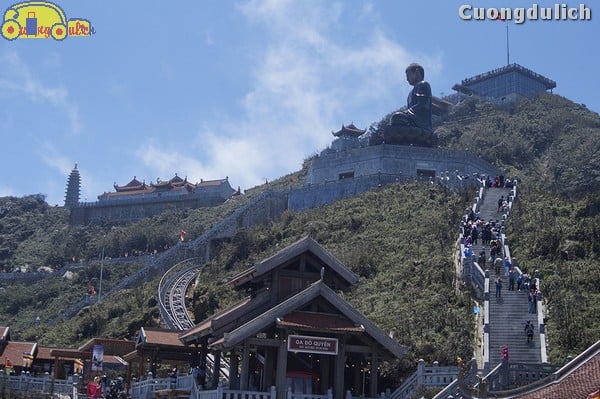
Also, please note that cable car tickets are only valid for the day of purchase, so it’s not advisable to buy them in advance to hold onto if you don’t have time to go up Fansipan on that day.
Furthermore, buying tickets directly sometimes requires waiting in line for a long time. Therefore, the best way is to book Fansipan cable car tickets online, so you don’t have to wait in line, get a discounted price, and have the option for free ticket exchange.
It’s also important not to bring too much luggage or bulky items as the management won’t allow you to enter the cable car cabin.
d. Schedule of the cable car route to the top of Fansipan

The cable car route starts from Muong Hoa Valley up to the summit of Fansipan. Each cabin of the Fansipan Sapa cable car can accommodate up to 30 to 35 passengers, with a transport capacity of up to 2,000 passengers per hour, shortening the travel time to the top of Fansipan to just 15 minutes instead of the treacherous 2-day journey by road. With such high capacity, you can see that no matter how many visitors flock to Sapa and want to conquer the towering Fansipan peak, this cable car system can handle it.
While riding the cable car from Muong Hoa Valley to the summit of Fansipan, due to the altitude difference of 1,410 meters between these two points, you may experience ear popping and mild altitude sickness as your body may not adapt quickly to the new altitude. The best way to reduce these effects is to breathe deeply and regularly. Additionally, you should bring a scarf to wrap around your neck and warm clothing as the temperature at the summit is lower and the wind is stronger. If you feel shortness of breath or any unusual symptoms, you should immediately contact the staff at the station for medical assistance.

With the most modern three-rope system in the world, the Fansipan Sapa cable car is capable of withstanding strong winds and harsh weather conditions, ensuring absolute safety for tourists, so you can rest assured. The higher you go, the more clouds there will be, the temperature will drop, and if there is wind, the cable car may sway a bit, but don’t worry, the feeling of swaying a bit is just more exciting!
To help you feel less scared, Cuồng suggests a very good way for you to freely admire the panoramic view of the romantic Muong Hoa Valley along with Hoang Lien National Park and the Hoang Lien Son mountain range overlapping from above with the sky, flowers, leaves, and mountains blending together to create a colorful landscape painting. You will feel like you are lost in a fairyland, passing through floating clouds in the sky.
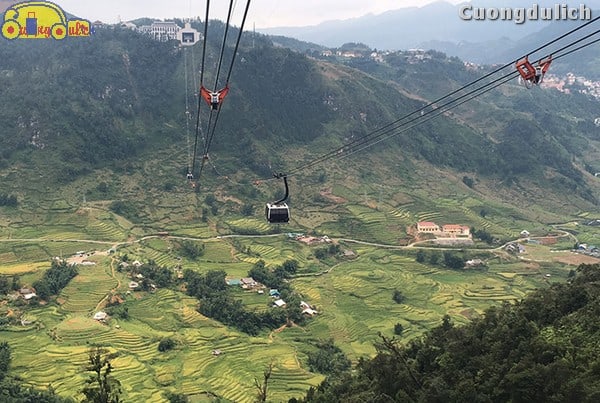
At an altitude of nearly 3,000 meters, you will descend by cable car. Here, to reach the summit of Fansipan mountain, you have 2 choices. Either climb an additional 600 steps or use the train service to the top of Fansipan mountain for a price of 150,000 VND per person. If you choose to climb the 600 steps, it will take about 20 minutes to reach the top of Fansipan, officially touching the roof of Indochina. For those who prefer the train, you can choose to buy a one-way ticket or a round-trip ticket to descend the mountain, this feeling is very suitable for singing the song “Tàu Anh Leo Núi”.

On the 600-step path to the top of Fansipan, you will pass by the Lower Pagoda to the Upper Pagoda, where you will hear gentle meditation music playing in the space. Here, slow down, listen carefully, and you will feel your soul peaceful and serene as you step into the realm of Buddha.
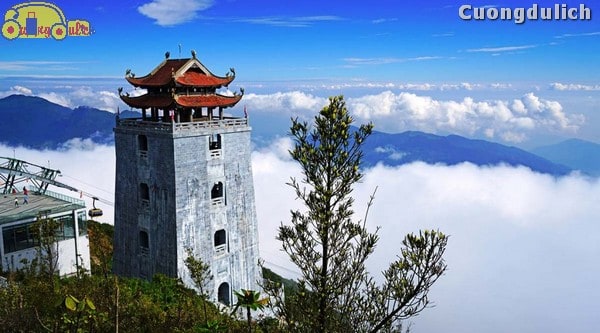
Close to Ha Temple, you will pass by Van Son Tra Quan. Cuong really likes the tea style here, sitting on low stools and low tables. The tea style combined with the spiritual place of the Buddhist realm at the top of Fansipan is very suitable. Sitting on the edge of the earth and sky with clouds surrounding you, you can enjoy a cup of hot tea, admire the blooming azaleas, and feel the peaceful atmosphere everywhere.

4. What is there on the top of Fansipan?
After proudly raising the national flag with friends and taking all kinds of trendy photos with the stainless steel peaks on the top of Fansipan, you can continue to explore nearby attractions. Fansipan Legend area is vast, so you can either spend two days trekking up the mountain or pay 700k to take the cable car all the way to the top. You can freely explore the Bamboo Garden, Bao An Pagoda, Bich Van Pagoda, restaurants, shopping areas, etc. According to Cuong, it may take you half a day to fully explore the entire Fansipan Legend area.
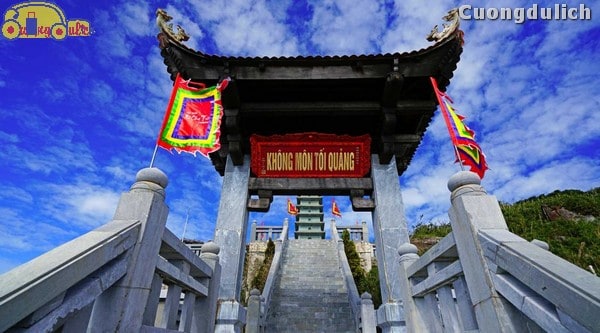
When you step out of Fansipan station, you will immediately encounter Thanh Phong Thien Pagoda, where you can write prayers for yourself and your family. Put your hands together in prayer in front of the largest statue of Amitabha Buddha in Vietnam, standing at 21.5 meters. This bronze Buddha statue is considered a symbol of the spiritual culture of Fansipan. Additionally, there is Kim Son Bao Thang Pagoda, Dai Bao Palace with many Buddha statues carved by monks, the Arhat path with 18 bronze Arhat statues, and many other Buddhist structures nearby such as the statue of Guanyin Bodhisattva, the pagoda, and more…
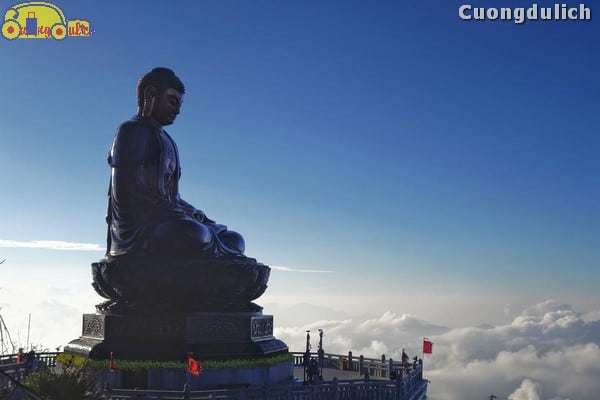
After taking the cable car to the top of Fansipan, if you feel hungry or thirsty, you can visit some restaurants nearby. Cuong would like to recommend Do Quyen restaurant at Fansipan station and Hai Cang restaurant at Sapa station. Eating there is of course a bit pricey. Bottled water costs 20k per bottle, rice dishes range from 80k to 130k per person, and pizza is only available in one size, large. Cuong and his friends ordered a pizza and some drinks. The food was quite satisfying, delicious, and just right for three people. Cuong noticed that the restaurants at the top of this mountain still offer a diverse menu, including both European and Asian dishes, as well as local specialties of Sapa such as pork hotpot, salmon hotpot, grilled fish, and more.
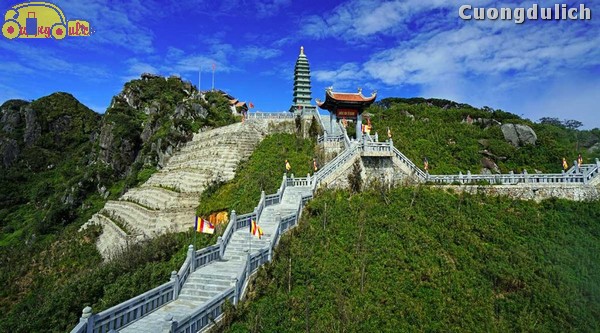
Currently, the accommodation at the Fansipan Legend cable car complex is still not completed and operational. Visitors can only explore during the day and are not allowed to stay overnight at the summit. The only hotel under construction is the MGallery in the center of Sapa town. The hotel also serves as the starting point for the mountain railway to Sapa station (Mường Hoa station) in the Sun Plaza complex. However, don’t worry too much, as the mountain railway station is located right in the center of Sapa, so you can still stay at nearby hotels such as Sapa Charm, Amazing Sapa, Pao’s Sapa Leisure, Silk Path Grand, Sapa Highland… and walk to the station.
Video guide to Fansipan Sapa
5. Tourist spots near the summit of Fansipan in Sapa
5.1 Stone Church in Sapa

Located in the center of Sapa town, bearing the French architectural imprint. In front of the church is the central square, where the Love Market takes place on weekends.
5.2 Dragon Jaw Mountain
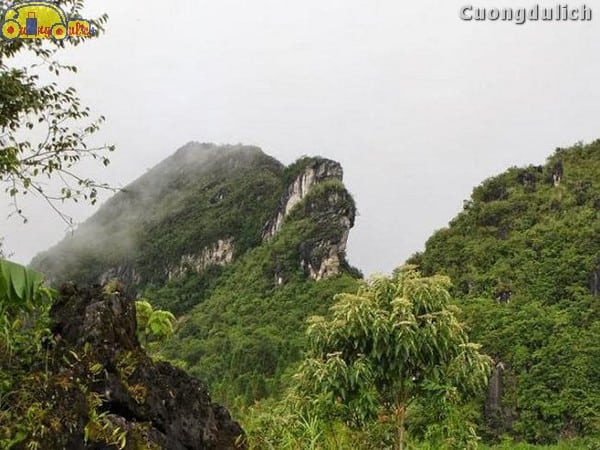
Located near the center of Sapa town, it has a shape resembling a dragon’s head. When visiting Ham Rong Mountain, you will pass through many beautiful landscapes such as orchid gardens, peach gardens, Cloud Yard, Heaven’s Gate…
5.3 Cat Cat Village
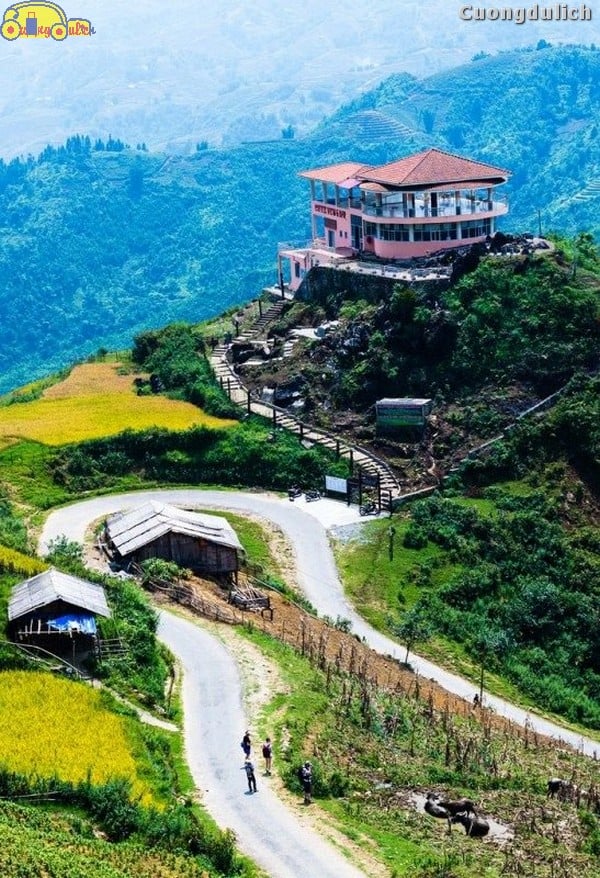
Located at the foot of the Hoang Lien Son mountain range and the peak of Fansipan. Here, you can visit the terraced rice fields, Cat Cat stream, Cat Cat waterfall with foaming white water…
So Cuong has provided you with a detailed review of the entire process of conquering Fansipan peak in both ways: trekking and taking the cable car, from preparation, things to note during the journey, ticket purchase, route, places to eat and visit on Fansipan peak. You can refer to Sapa travel tours for full support from travel companies, taking you from Hanoi to Sapa. When you reach the top of Fansipan, don’t forget to capture memorable moments with the national flag next to the milestone and send Cuong the photos!
